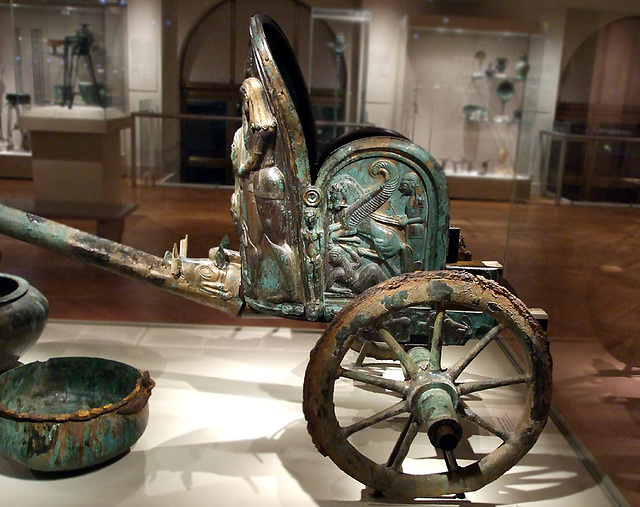Location
Lat, Lng: 40.779509, -73.963458
You can copy the above to your favourite mapping app.
Address: Sigmund Pretzel Cart
You can copy the above to your favourite mapping app.
Address: Sigmund Pretzel Cart
See also...
Keywords
Authorizations, license
-
Visible by: Everyone -
All rights reserved
-
941 visits
Detail of the Etruscan Bronze Chariot in the Metropolitan Museum of Art, February 2008


Chariot, late 6th century B.C.
Etruscan; From Monteleone, Italy
Bronze; H. 51 1/2 in. (130.8 cm)
Rogers Fund, 1903 (03.23.1)
Although chariots are frequently represented in all forms of ancient art, they were no longer used in warfare by the sixth century B.C.; rather, the scenes in which they appear refer to an earlier, mythological period. This chariot was found in a tomb in Monteleone, Italy, and probably saw little actual use before it was buried with its owner. It is exceptional for its state of preservation and exquisite hammered relief decoration. The pole of the chariot issues from the head of a boar and ends in the head of a beaked bird. The principle subjects on the three parts of the chariot box refer to the life of a hero, most likely Achilles. In the center, Achilles receives armor from Thetis, his mother. On one side, he engages in combat with another hero, possibly Memnon; on the other side, he appears in a chariot drawn by winged horses. While the style and subject of the reliefs look to Greek art and myth, the treatment of the scenes is thoroughly Etruscan.
Text from: www.metmuseum.org/toah/ho/04/eust/hod_03.23.1.htm
Etruscan; From Monteleone, Italy
Bronze; H. 51 1/2 in. (130.8 cm)
Rogers Fund, 1903 (03.23.1)
Although chariots are frequently represented in all forms of ancient art, they were no longer used in warfare by the sixth century B.C.; rather, the scenes in which they appear refer to an earlier, mythological period. This chariot was found in a tomb in Monteleone, Italy, and probably saw little actual use before it was buried with its owner. It is exceptional for its state of preservation and exquisite hammered relief decoration. The pole of the chariot issues from the head of a boar and ends in the head of a beaked bird. The principle subjects on the three parts of the chariot box refer to the life of a hero, most likely Achilles. In the center, Achilles receives armor from Thetis, his mother. On one side, he engages in combat with another hero, possibly Memnon; on the other side, he appears in a chariot drawn by winged horses. While the style and subject of the reliefs look to Greek art and myth, the treatment of the scenes is thoroughly Etruscan.
Text from: www.metmuseum.org/toah/ho/04/eust/hod_03.23.1.htm
- Keyboard shortcuts:
Jump to top
RSS feed- Latest comments - Subscribe to the comment feeds of this photo
- ipernity © 2007-2025
- Help & Contact
|
Club news
|
About ipernity
|
History |
ipernity Club & Prices |
Guide of good conduct
Donate | Group guidelines | Privacy policy | Terms of use | Statutes | In memoria -
Facebook
Twitter











Sign-in to write a comment.